A fantasy crafted from Jewish archetypes
The early Christians scribes, convincing themselves that their Lord and Saviour had indeed walked upon the earth, drew most of their inspiration for his brief “ministry” and wonder-working from the vast stock of Jewish sacred writings. Not history but plagiarism put flesh on their notions of a spiritual saviour.
Scavenging through the pious romances and holy heroics of Hebrew scripture they found edifying story lines and useful characterisation to fill a whole eight weeks or so of “biography” – and that includes 40 days and nights in the wilderness. Useful extra detail was gleaned from the works of Josephus, the Jewish historian and a handful of other texts. In time, of course, this so-called “life” would all be back-projected as the “fulfillment of prophecy” – art imitating artifice. Only the rational mind sees plagiarism and deceit.
To those who already “believed” it was the majestic design of an ineffable God, weaving the wondrous image of his only begotten son across several centuries of Jewish history, the misadventure and internecine strife of an entire people reduced to the prologue for the Christian godman.
Profiting from the Prophets
– Robin Lane Fox, The Unauthorized Version, p340.
The 6th to 2nd centuries BC was a golden age of Jewish prophecy, a time when the priests of Judaism invented soothsayers both major and minor (about 17 of them in all) whose prescience rationalized each successive calamity and tribulation.
Words from On High – "End Time Prophet"
Despite the presence of the holy man the widow’s child died but his death afforded Elijah the opportunity – with the True God’s help, of course – to raise him back to life:
“And the LORD heard the voice of Elijah; and the soul of the child came into him again, and he revived.”
– 1 Kings 17.22
“And it came to pass, as they were burying a man, that, behold, they spied a band of men; and they cast the man into the sepulcher of Elisha: and when the man was let down, and touched the bones of Elisha, he revived, and stood up on his feet.” – 13.21
Why waste a good yarn?

Hill of Moreh, south side (Shunem). Elisha raises the dead son – the only child – of an old woman. (2 Kings 4.32,35).
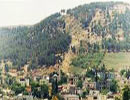
Hill of Moreh, north side (Nain). Jesus raises the dead son – the only child – of an old woman. (Luke 7.11,15).
The Seed Bed of Saviours
Enoch
“Jesus” has to wait for the later re-make to get the starring role!
From Enoch to Jesus?
In this entertaining drivel, Enoch himself doesn’t get a mention but a character called Christ is moving up the pecking order.
Melchizedek, King of Salem
– Oxford Companion to the Bible, p511,512.
From Melchizedek to Jesus?
– Hebrews 7.15,17
The homage paid by Abraham to Melchizedek in the original Genesis verse, therefore, could be held to “prefigure” the subordination of Judaism to its upstart heresy – Christianity.
Michael the Archangel
Who is this “one like the Son of Man”? The archangel Michael? Daniel himself? The Messiah? Of course, there is no clear answer.
Daniel inspired the author of Revelation and unlike the Gospels, Revelation is a genuine 1st century tract. In this apocalyptic vision the Christ character is far from fully developed. Christ vies with Moses and Michael in the celestial pecking order, rival agents of God’s will.
Shape-Shifters
Where Did They Get Their Ideas From?
“For we have not an innumerable multitude of books among us, disagreeing from and contradicting one another, as the Greeks have, but only twenty-two books, which contain the records of all the past times; which are justly believed to be divine.”
– Josephus, Against Apion, 1.8 c. 100.
“Those who undertake to write histories, do not, I perceive, take that trouble on one and the same account, but for many reasons … there are not a few who are induced to draw their historical facts out of darkness into light, and to produce them for the benefit of the public, on account of the great importance of the facts themselves with which they have been concerned.”
– Josephus, Antiquities of the Jews
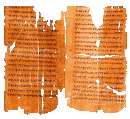
Sources:
- J. R. Porter, The Lost Bible (Duncan Baird, 2001)
- Nicholas Carter, The Christ Myth (Historical Review Press, 1993)
- Michael Grant, Jesus (Weidenfeld & Nicolson, 1977)
- N. Page, The Bible Book (Harper Collins, 2002)
- Robin Lane Fox, The Unauthorized Version (Penguin, 1991)
- J. Packer, D. Williams The Bible Application Handbook (Eagle, 1999)
- Thomas Sheehan, The First Coming (Random House 1986)
- Gordan Thomas, The Trial (Bantam, 1987)
Related Article:
Man or Myth?
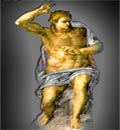

"Oh No! It's Elijah, the Tishbite!"
What's in a name?
Eli’sha = God is salvation
Eli’jah = God is Jehovah
Je’sus (Yeshua) = Jehovah saves

Qumran – Many Tenants
War Scroll

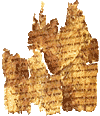
The Real Deal
The Christian novelists strove to deflate the claims of rival John the Baptist fans. They identified the Baptist as both JC’s cousin and as a reborn “Elijah” – reducing him to a mere forerunner of the “real thing”.
Temple Scroll.
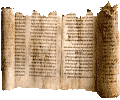

Consolidating the Lord
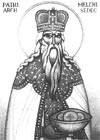
"Melchizedek" – a play on the words "righteous peacemaker".

"Archangel Michael" – another member of JC's extended family.
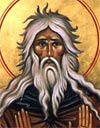
So who is it – Elijah? Enoch? Melchizedek? Michael? Why don't we just call him Jesus?

